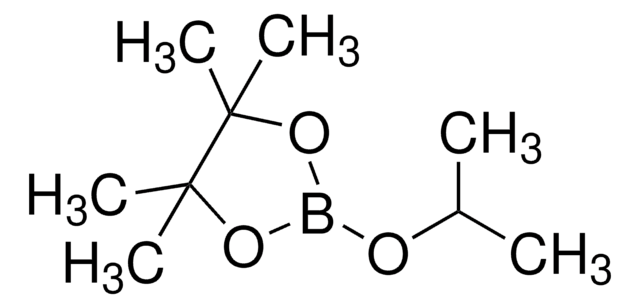Kluczowe dokumenty
186171
n-Butyllithium solution
1.6 M in hexanes
Synonim(y):
n-BuLi, Butyl lithium, Butyllithium solution, Lithium-1-butanide
About This Item
Polecane produkty
Formularz
liquid
Poziom jakości
stężenie
1.6 M in hexanes
gęstość
0.68 g/mL at 25 °C
temp. przechowywania
2-8°C
ciąg SMILES
[Li]CCCC
InChI
1S/C4H9.Li/c1-3-4-2;/h1,3-4H2,2H3;
Klucz InChI
MZRVEZGGRBJDDB-UHFFFAOYSA-N
Szukasz podobnych produktów? Odwiedź Przewodnik dotyczący porównywania produktów
Zastosowanie
- Copolymerization of butadiene and styrene under the influence of n-butyllithium: This study explores the copolymerization process using n-butyllithium as a catalyst, which is significant for the development of new synthetic rubber materials (V Bronskaya et al., 2023).
- Modifiers of n-Butyllithium in the Synthesis of Polybutadiene and Styrene-Butadiene Rubbers: Explores the use of n-butyllithium with different modifiers in the synthesis of industrial rubbers, important for understanding the control of polymer properties (VS Glukhovskoi et al., 2014).
- Aggregation and Solvation of n-Butyllithium: Examines the aggregation behavior and solvation properties of n-butyllithium in various solvents, providing insights into its chemical interactions essential for organic synthesis (O Tai et al., 2017).
Opakowanie
The 25 mL Sure/Seal™ bottle is recommended as a single-use bottle. Repeated punctures will likely result in decreased performance of product.
Inne uwagi
Informacje prawne
produkt powiązany
Hasło ostrzegawcze
Danger
Zwroty wskazujące rodzaj zagrożenia
Zwroty wskazujące środki ostrożności
Klasyfikacja zagrożeń
Aquatic Chronic 2 - Asp. Tox. 1 - Eye Dam. 1 - Flam. Liq. 2 - Pyr. Liq. 1 - Repr. 2 - Skin Corr. 1B - STOT SE 3 - Water-react 1
Organy docelowe
Central nervous system
Zagrożenia dodatkowe
Kod klasy składowania
4.2 - Pyrophoric and self-heating hazardous materials
Klasa zagrożenia wodnego (WGK)
WGK 3
Temperatura zapłonu (°F)
-14.8 °F - closed cup
Temperatura zapłonu (°C)
-26 °C - closed cup
Wybierz jedną z najnowszych wersji:
Masz już ten produkt?
Dokumenty związane z niedawno zakupionymi produktami zostały zamieszczone w Bibliotece dokumentów.
Klienci oglądali również te produkty
Nasz zespół naukowców ma doświadczenie we wszystkich obszarach badań, w tym w naukach przyrodniczych, materiałoznawstwie, syntezie chemicznej, chromatografii, analityce i wielu innych dziedzinach.
Skontaktuj się z zespołem ds. pomocy technicznej











